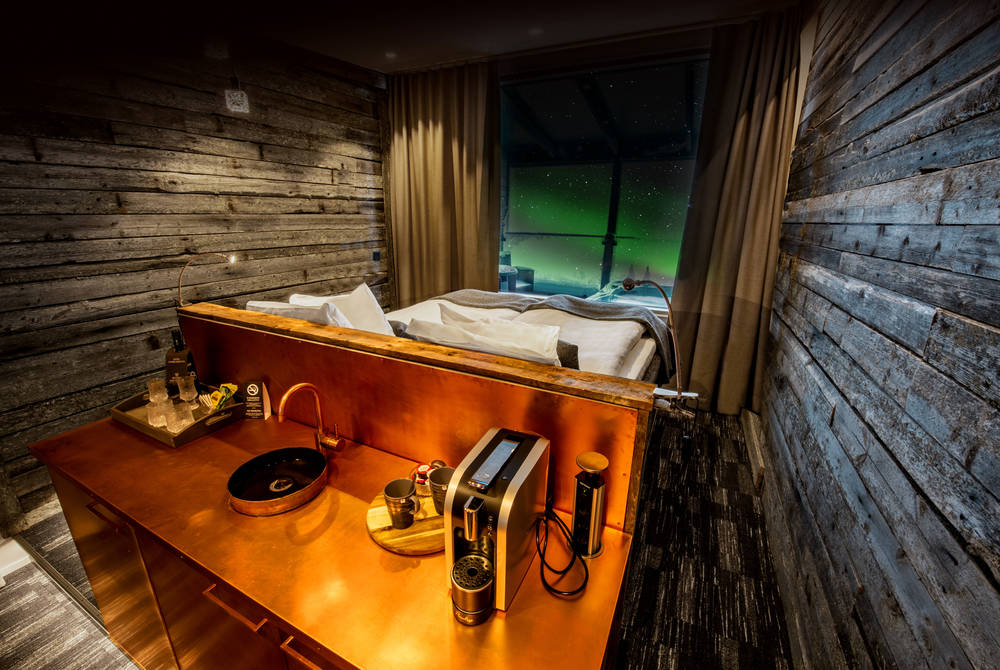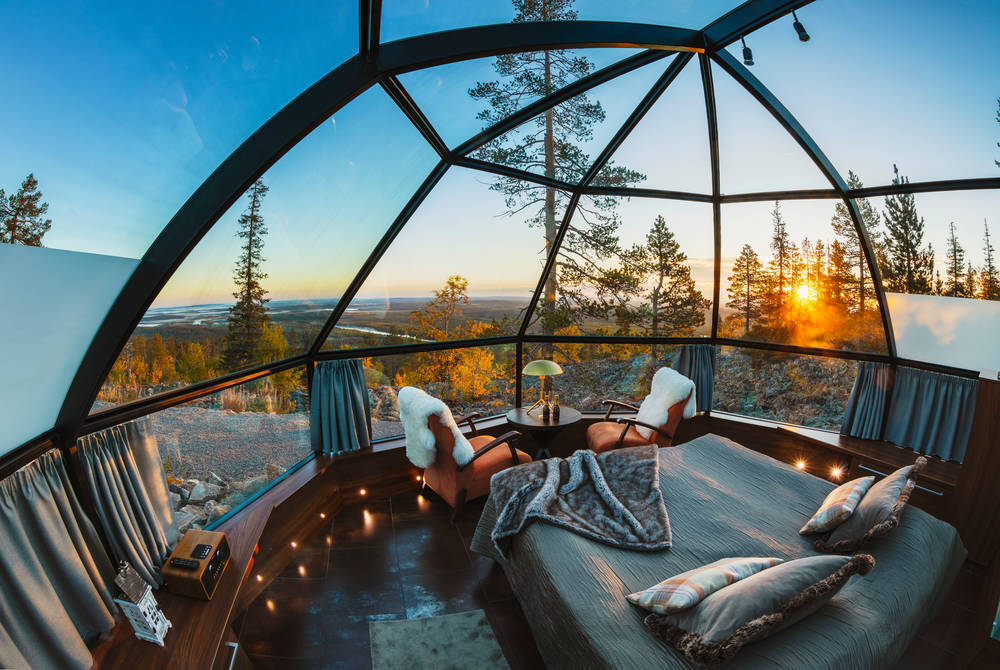Finnish Lapland encompasses the northern third of Finland, a region of rolling fells, sprawling boreal forests, glittering lakes and rugged tundra landscapes. It’s Finland’s largest region by geographical area, but home to just 3.5% of the country’s total population, making it one of the most sparsely populated places in Europe. In fact, there are more reindeer (around 200,000) in Finnish Lapland than people (around 180,000). The vast majority of Finnish Lapland lies within the Arctic Circle, and with excellent international and domestic flight connections, it’s one of the most accessible Arctic destinations in the Nordics. But, with such dramatic seasonal contrasts, the range of experiences and activities on offer varies significantly depending on when you visit. So, we’ve prepared this guide to help you choose the best time to plan your ideal trip.
Best time to visit Finnish Lapland for the Northern Lights: September – March

Northern Lights, Finnish Lapland
Finnish Lapland lies between the latitudes of 65.5°N – 70°N, directly beneath the auroral oval, making it one of the best and most accessible places in the world to see the Northern Lights. The nights become dark enough for the first auroras to be visible in mid-to-late August, but the Northern Lights season really gets going in September. In autumn, temperatures are still relatively comfortable and the lakes aren’t yet frozen, which presents the possibility of seeing the Northern Lights reflecting on the water – a truly awe-inspiring spectacle.
The period around the autumn equinox is often associated with elevated levels of geomagnetic activity, which can produce particularly impressive Northern Lights displays. For this reason, late September and early October are considered prime time for aurora hunting. The same applies with the spring equinox, making March another excellent month for chasing the Northern Lights.

Wilderness Hotel Nangu
The aurora season extends all the way through to mid-April in Finnish Lapland, after which the lack of true darkness at night soon renders the Northern Lights invisible (even though they’re technically ‘active’ all year round). Towards the beginning and end of the Northern Lights season, you have to stay up later at night for a chance of seeing the Northern Lights due to the limited window of darkness, hence why we recommend going between September and March.
November, December and January provide the longest hours of darkness, but a key factor is always cloud cover, as you need clear (or at least partially clear) skies in order to see the Northern Lights. This is why we recommend joining a guided Northern Lights hunt, as your guide will analyse the latest weather conditions and drive to a location with optimal viewing conditions to maximise your chances of seeing the Northern Lights on any given night.
Best time to visit Finnish Lapland for snow-based activities: December – March

Snowmobiling in Finnish Lapland
Winter is by far the most popular time to visit Finnish Lapland. The landscapes take on a particularly enchanting quality when thickly blanketed in snow, providing perfect conditions for a whole host of thrilling outdoor activities, such as husky sledding, snowmobiling, snowshoeing, ice fishing and cross-country skiing.
The first snowfall tends to arrive in late September or early October, often melting away again before forming thicker cover on the ground throughout November and December. However, this varies quite significantly throughout different parts of Finnish Lapland and from year-to-year. For instance, while the likes of Ivalo and Levi might already have substantial snow cover by late October or early November, it could take several more weeks for heavy snow to arrive in Rovaniemi, which lies significantly further south.

Husky sledding, Finnish Lapland
While snow-based activities are usually possible in December, snow conditions are less predictable earlier in the month – particularly further south. In the north of Finnish Lapland, there is no sunrise at all throughout December, but it isn’t totally dark 24/7 – there’s still an extended period of twilight with soft, paste-hued light that lasts for several hours, which provides a sufficient window for outdoor activities. The sun then returns in early-mid January, and the hours of daylight increase considerably throughout February and March.
Snow cover is generally at its thickest throughout Finnish Lapland from January to March, with temperatures mostly in the region of -5°C to -20°C. This is therefore the most reliable time for snow-based activities. Occasionally, temperatures may rise just above 0°C or dip to -30°C, so it’s best to be prepared for all scenarios. Activity providers typically lend thermal suits, gloves, headwear and winter boots to keep you warm when heading out on the likes of husky sledding and snowmobiling excursions. Some snow-based activities may still be possible in early April, but by this time the winter season is very much winding down and the snow gradually melts away.
Best time to visit Finnish Lapland for families with children: December

Reindeer sledding near Rovaniemi, Finnish Lapland (Credit: Visit Rovaniemi)
Tourism in Finnish Lapland reaches a crescendo in December, when families flock from all around the world to see Santa and experience a true winter wonderland brimming with festive cheer. A Christmas break in Finnish Lapland is a magical experience for adults and children alike, but due to the elevated demand at this time of year, it’s essential to plan far in advance, as many hotels become completely booked up. Unsurprisingly, prices of flights and accommodation are at their highest in December – especially over Christmas and New Year. While there’s less reliability regarding snow conditions, prices and availability do tend to be more favourable in late November or early December.
If you’re planning a family trip to Finnish Lapland with older children and Santa isn’t on the agenda, January (after New Year) to March is the best time to go. This is an ideal period for snow-based activities and seeing the Northern Lights, when the region is noticeably less busy and prices are significantly lower. And if you do still want to experience a taste of Christmas, Santa Claus Village – just outside of Rovaniemi – is open every day of the year.
Best time to visit Finnish Lapland for the Midnight Sun: Late May – July

Midnight Sun, Finnish Lapland
In the northernmost part of Finnish Lapland, the sun doesn’t dip below the horizon for over two months between mid-May and late July. Further south, in Rovaniemi, the Midnight Sun lasts for a shorter window of around one month, between roughly 6th June – 6th July. Also, in the weeks just before and after the Midnight Sun, there’s no true darkness at night in Finnish Lapland, as the days merge seamlessly into one another.
It’s a remarkable phenomenon to experience, allowing the possibility of hiking in the forests, swimming in the lakes or simply sitting outside and reading a book right through the early hours of the morning. For those unaccustomed to the seasonal extremes of living inside the Arctic Circle, the lack of darkness can be somewhat discombobulating at first, especially when it comes to maintaining a regular sleeping pattern.
You may also be surprised by how warm it can get in Finnish Lapland during the summer months; it’s not uncommon for temperatures to climb above 20°C. If you’re visiting at this time of year, do bear in mind that mosquitoes are prevalent, so light, long-sleeved clothing, netted hats and strong insect repellent are highly recommended – especially when you’re out hiking in the wilderness.
Best time to visit Finnish Lapland for wildlife watching: May – August

Brown bear, Finnish Lapland
Finland is home to an estimated 1,500-2,000 Eurasian brown bears, the majority of which are found in the boreal forests in the east and north of the country, including in Lapland and neighbouring areas (such as Ruka-Kuusamo, in Northern Ostrobothnia). While spotting a bear in the wild is rare, it’s possible to see them from a safe distance when visiting a bear hide – a purpose-built structure designed for observing and photographing bears in their natural habitat.
Bears typically emerge from their winter hibernation in April, at which point there is usually still snow on the ground, as they begin foraging and feeding in the forests. They tend to be most active in late spring and throughout the summer months – especially early in the mornings and late in the evenings – with May, June, July and August therefore representing the peak time for bear watching in Finland. Rather conveniently, the summer months offer endless daylight, while late August and September mix in the possibility of seeing the Northern Lights at night. By the end of October, the bears begin to retreat to their dens as they prepare to go back into hibernation.
As well as bears, also be sure to keep your eyes peeled for all kinds of other wildlife in Finnish Lapland; the region is also home to moose, reindeer, wolves, wolverines, lynxes and Arctic foxes.















